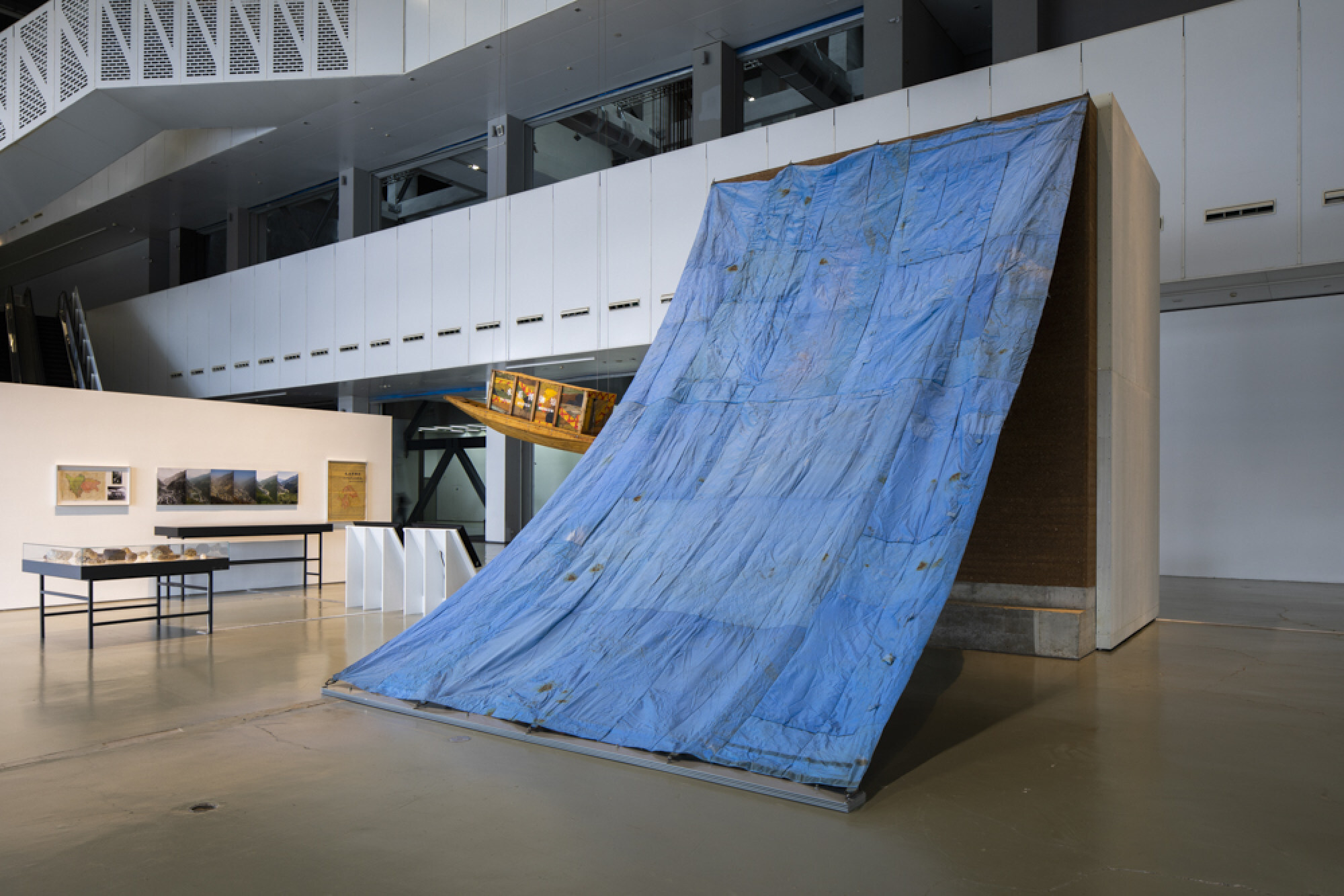Source: SCMP (4/24/21)
Water-themed Shanghai Biennale feels diluted by satellite art shows away from the main venue
Irrigation, menstruation, immersion – Bodies of Water, the main exhibition at the 13th Shanghai Biennale, takes a wide-ranging view of its theme. The show is a great introduction to the work of younger, less well known artists
By Lisa Movius

Quipu Menstrual (Shanghai) (2006/2021), by Cecilia Vicuña on show at the Power Station of Art as part of the 13th Shanghai Biennale, whose theme is water. Photo: Power Station of Art
Pandemic-era biennales are bound to have detours and tributaries, like rivulets fanning across parched land when the rain arrives after a long drought.
The main exhibition of the 13th Shanghai Biennale, called “Bodies of Water”, has just opened at the Power Station of Art (PSA) after a near six-month delay. It is smaller than its recent predecessors and builds upon public forums held during the intended opening dates last November and an ongoing series of academic projects.
The biennale is also branching out by having satellite shows and interventions across the city, and an app to take people on guided tours of Shanghai’s waterways. As a result, the main exhibition is left somewhat diluted, instead of making waves with its environmental theme of alliances built across species and nations.
The massive entrance hall of the former power station is designed to make a splash, and ever since the biennale moved there in 2012, that space has tended to feature enormous, often controversial, statement pieces that set the tone for entire shows.

Power Station of Art in Shanghai, venue of the 13th Shanghai Biennale. Photo: Power Station of Art
For “Bodies of Water”, though, New York-based curator Andrés Jaque has opted for the sort of quiet, research-based multimedia projects usually relegated to the museum’s labyrinthine upper corridors.
Cao Minghao and Chen Jianjun’s 2018-2021 “Water System” series explores the environmental impact of Sichuan Province’s ancient Dujiangyan irrigation project through a dense collection of materials and documentary video. It provides a defining thesis for the wide-ranging biennale but, sitting in that large space, it is representative of how the entire biennale is ultimately a thoughtful, if diffuse, wading pool of ideas lacking in visually powerful highlights.

Part of Cao Minghao and Chen Jianjun’s Water System Museum (2018) in the entrance hall of the Power Station of Art. Photo: Power Station of Art
The boldest presentation in PSA is Cecilia Vicuña’s Quipu Menstrual (Shanghai) (2006/2021) in the second floor atrium. Vicuña’s red-dyed raw wool knotted together using the techniques of Mayan quipu (knots used as memory aides) evokes the clots in menstrual blood.
The visual reference to viscous viscera is meant to be discomfiting, especially to the never-menstruating, and it is a powerful work that ties in with Vicuña’s activism regarding indigenous water rights and the idea that water has history and memory.
I am particularly interested in water’s visceral power to make and awaken memories and I went to the show looking for it. As an obsessive swimmer, immersion in different temperatures, tastes and lights can recall encounters with other bodies of water and associated memories: the California seas I visited as a child with my grandfather, Beijing’s palace lakes during a Polar vortex, the balmy clarity of Malaysian inlets and the muddy creeks of Shanghai (a city upon an ocean, according to its name).

Part of Cao Minghao and Chen Jianjun’s Water System Museum (2018) in the entrance hall of the Power Station of Art. Photo: Power Station of Art
The closest I came to any sensation of immersion, though, was in the tucked away second floor room displaying Dai Chenlian’s commissioned series “Waxing and Waning of the Augustness” (2020-2021).
It combines a video piece with an installation by the Beijing-based theatre director and artist. His films of shadow puppets, inspired by ink art, dance around the darkened room’s walls and feels like a cool, underwater experience. Dai’s works delve into the surreal aspects of family life in a traditional Chinese water town and the personal challenge of learning how to speak with congenital cleft lip and palate.
He has a series of huge, propaganda-poster-like scroll paintings hung along the second floor corridor, documenting how his mother learned Chinese characters and pinyin as an adult.

Guo Fengyi’s ink paintings at the 13th Shanghai Biennale. Photo: Power Station of Art/Guo Fengyi
Adjacent to Dai’s section is an installation by the London-based Ibiye Camp. Remaining Threads (2021) explores the changing nature of the water-intensive textile industry in Buguma, Nigeria. Next to it, a wall text by Elizabeth A. Povinelli tells of a coastal tidal creek called Tjipel in Northern Australia that is supposed to be the spirit of a teenage girl murdered for pretending be a boy.
The pairing of Camp’s work with the text is an example of the charming replacement of ordinary wall labels with writings throughout the show.
Jaque and assistant curators Marina Otero Verzier, Lucia Pietroiusti, You Mi and Filipa Ramos delve ambitiously into a wide range of issues, from commerce and geography to ecology and biology. While the main exhibition comes across as a bit watery, it is a great introduction to many younger, less familiar names shown alongside a sprinkling of more established artists such as Vicuña, Joan Jonas, Liu Guang and Feliciano Centurion.
The PSA exhibition is phase three of the extended Biennale and is open to the public until July 25. For details visit https://www.powerstationofart.com/